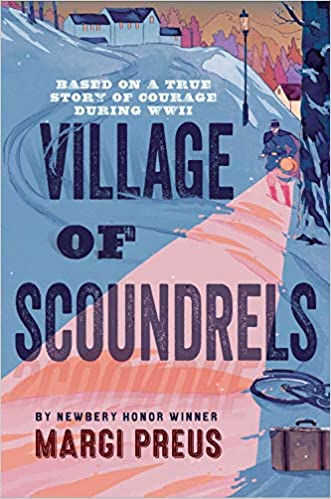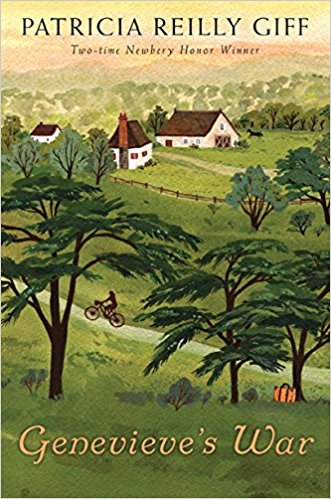
Village of Scoundrels
Margi Preus, Author
Amulet Books, Fiction, 2019
Suitable for ages: 10-14
Themes: Jews, Teens, Underground movements, Refugees, France, WW II, German occupation, Smuggling, Community
Synopsis:
Forging documents, smuggling people over the border, carrying coded messages for the French resistance — the teenagers of Les Lauzes find ways to help the refugees in their midst. For the first years of World War II, the remoteness of their village offers them a certain amount of protection and the townspeople take on the task of sheltering Jewish children rescued form French concentration camps. But as the Nazi occupiers infiltrate every corner of France, the noose tightens, and the operation becomes increasingly dangerous.
First, a French policeman, Officer Perdant, is sent to spy on their doings and uncover the village “scoundrels” — the teenagers, pastors and others who have been aiding the visitors. Little does he know that the villagers watch him. And when the Gestapo arrives with a list of names, the young people must race against time to get their new friends to safety.
Based on a true story, Village of Scoundrels tells how ordinary people opposed the Nazi occupation and stood up for what was right, in spite of intensifying peril.
Why I like this book:
Margi Preus‘ The Village of Scoundrels is a courageous and suspenseful tale that has many heart-stopping moments. Expertly researched, her story is based on the true stories of real people that are woven together into a fictionalized tale that involves danger and a desire to save human lives at the risk of losing their own. Led by their hearts and the will to do good, this extraordinary mountain village of scoundrels — teens, pastors, teachers, farmers and shop owners — stand together and save the lives of 3,200 Jews.
The story is set in Les Lauzes, a village surrounded by beautiful forests and farmland. It has a high school that “promotes peace and international unity” and attracts teens from all over France and Europe. There is no single location for this non-traditional school, as classes are held in many different places throughout the village. The students live in a variety of boarding houses in the village. So it is easy for Jewish children to fit in when they are rescued and brought to the school.
The story is driven by a cast of young and brave characters! There is John-Paul Filon, 17, a Jew who is the master forger of documents, identity cards, and ration books. He even forges a letter so he can attend medical school. Céleste, 16, is a Parisian and has become a courier for the resistance. Philippe, 17, is a red-headed student from Normandy who wears a Boy Scout uniform and helps smuggle Jewish refugees across the border into Switzerland. Henni, 17, and Max, 21, are concentration-camp survivors from Germany and meet again in Les Lauzes. The school provides a home for Henni, before she and Max flee to Switzerland. Jules is the local 10-year-old goatherd who knows the mountains, town and its secrets better than anyone. He passes messages and creates diversions. French Officer Perdant makes Jules his spy and their relationship is quite comic, as he outsmarts Perdant.
Madame Desault is a Jew from Paris, who rescues the children from the French concentration camps and brings them by train to the village. Madame Créneau is the organizer of the network and finds safe places for the refugees and smuggles children and others to Switzerland. Pastor Autin preaches peace and practices non-violent resistance.
I always welcome a new WW II book, because I realize that many of the survivors will soon be gone. It is so refreshing to read their stories. Each story offers a different perspective about how ordinary adults and children from many different countries come to the aid of the Jews and make a difference.
Favorite quote:
“We will resist,” Céleste whispered to herself. “Without fear.” After the sermon, Céleste had felt calm. Here was someone who knew what to do. Even if the whole world had gone mad, there was one man who knew what was right and was determined to live it. She felt a sense of purpose. She felt that everyone felt the same way, although no one spoke of it again. They simply began to live it. Pg. 154
Resources: Make sure you check out the Cast of Characters and a Pronunciation Guide at the beginning of the book. Read the Epilogue, because the author matches her characters with the real-life people who inspired her story. She includes photographs and detailed information about each person. There also is information on the school and guesthouses, the French Boy Scouts and concentration camps. She also includes a timeline and additional resources.
Margi Preus is the author of the Newbery Honor book Heart of of a Samurai and other books for young reachers that include West of the Moon, Shadow on the Mountain and The Bamboo Sword. Visit her at her website and on twitter @MagriPreus.
Greg Pattridge hosts Marvelous Middle Grade Monday posts on his wonderful Always in the Middle website. Check out the link to see all of the wonderful reviews by KidLit bloggers and authors.
*Reviewed from a library copy.

 Mari’s Hope (Book 3 in the Odin’s Promise Trilogy)
Mari’s Hope (Book 3 in the Odin’s Promise Trilogy) Odin’s Promise is a story of the first year of German occupation of Norway in World War II as seen through the eyes of a young girl. Eleven-year-old Mari grew up tucked under the wings of her parents, grandma, and older siblings. After Hitler’s troops invades Norway in Spring 1940, she is forced to grow beyond her “little girl” nickname to deal with harsh new realities. At her side for support and protection is Odin, her faithful elkhound. As the year progresses, Mari, her family, and her neighbors are drawn into the activities of the Norwegian underground resistance.
Odin’s Promise is a story of the first year of German occupation of Norway in World War II as seen through the eyes of a young girl. Eleven-year-old Mari grew up tucked under the wings of her parents, grandma, and older siblings. After Hitler’s troops invades Norway in Spring 1940, she is forced to grow beyond her “little girl” nickname to deal with harsh new realities. At her side for support and protection is Odin, her faithful elkhound. As the year progresses, Mari, her family, and her neighbors are drawn into the activities of the Norwegian underground resistance. Bjorn’s Gift is the second book in the trilogy and continues the exciting adventures of Mari, who faces growing hardships and dangers in her small village in a western fjord. German occupation troops and local Nazi supporters move closer to her family’s daily life, and her classmate Leif becomes active in the Norwegian Nazi youth party. Mari struggles to live up to her brother Bjorn’s faith in her, as she becomes more involved in risky resistance activities, trusting only her family and a few close friends. Across Norway, oppressive laws are imposed in the months from late 1941 to early 1943, with dire local consequences. Still, difficult decisions force Mari to admit that many things in life are not easily sorted into good or bad, and she begins to wonder if Hitler will ever be defeated and whether the occupation of Norway will ever end.
Bjorn’s Gift is the second book in the trilogy and continues the exciting adventures of Mari, who faces growing hardships and dangers in her small village in a western fjord. German occupation troops and local Nazi supporters move closer to her family’s daily life, and her classmate Leif becomes active in the Norwegian Nazi youth party. Mari struggles to live up to her brother Bjorn’s faith in her, as she becomes more involved in risky resistance activities, trusting only her family and a few close friends. Across Norway, oppressive laws are imposed in the months from late 1941 to early 1943, with dire local consequences. Still, difficult decisions force Mari to admit that many things in life are not easily sorted into good or bad, and she begins to wonder if Hitler will ever be defeated and whether the occupation of Norway will ever end.